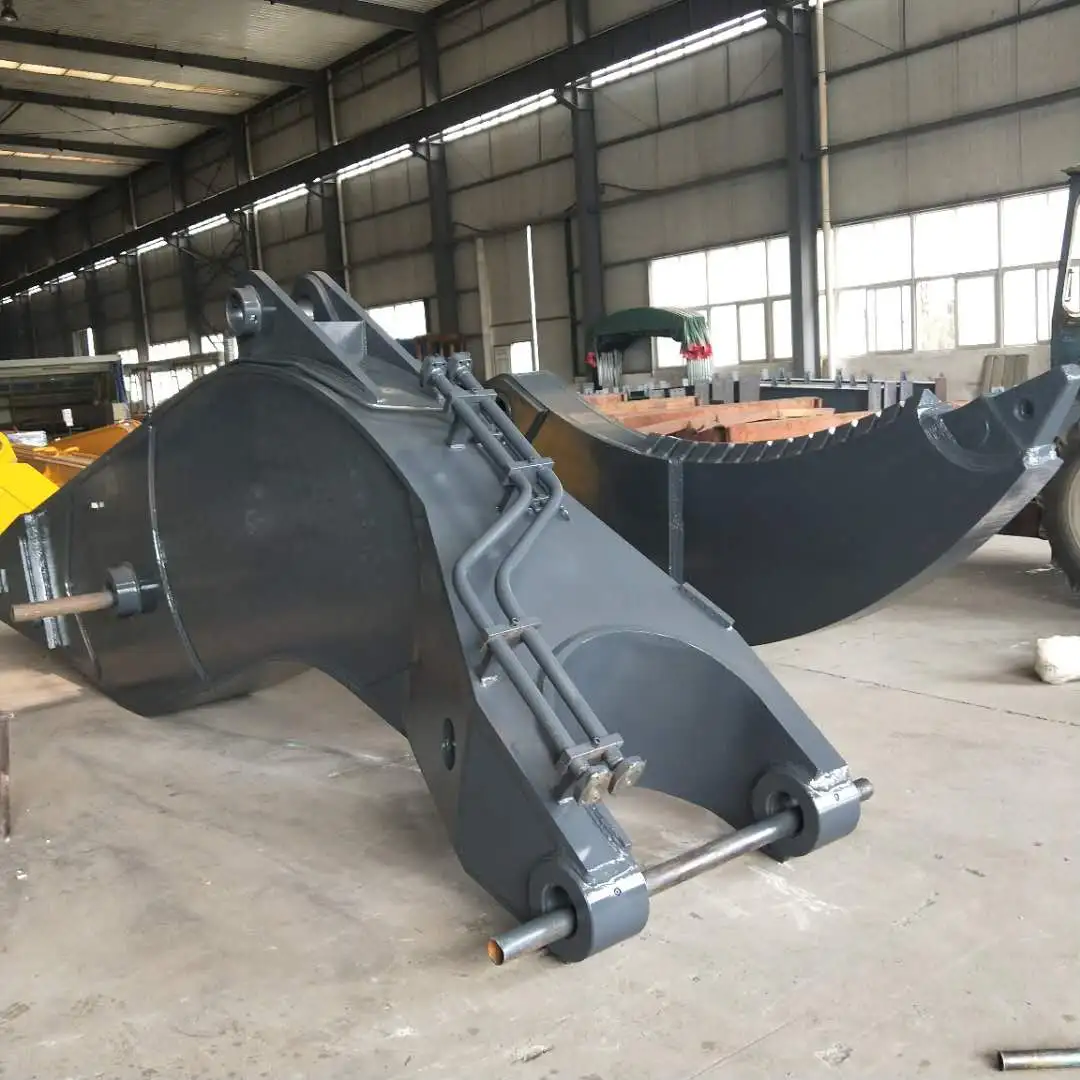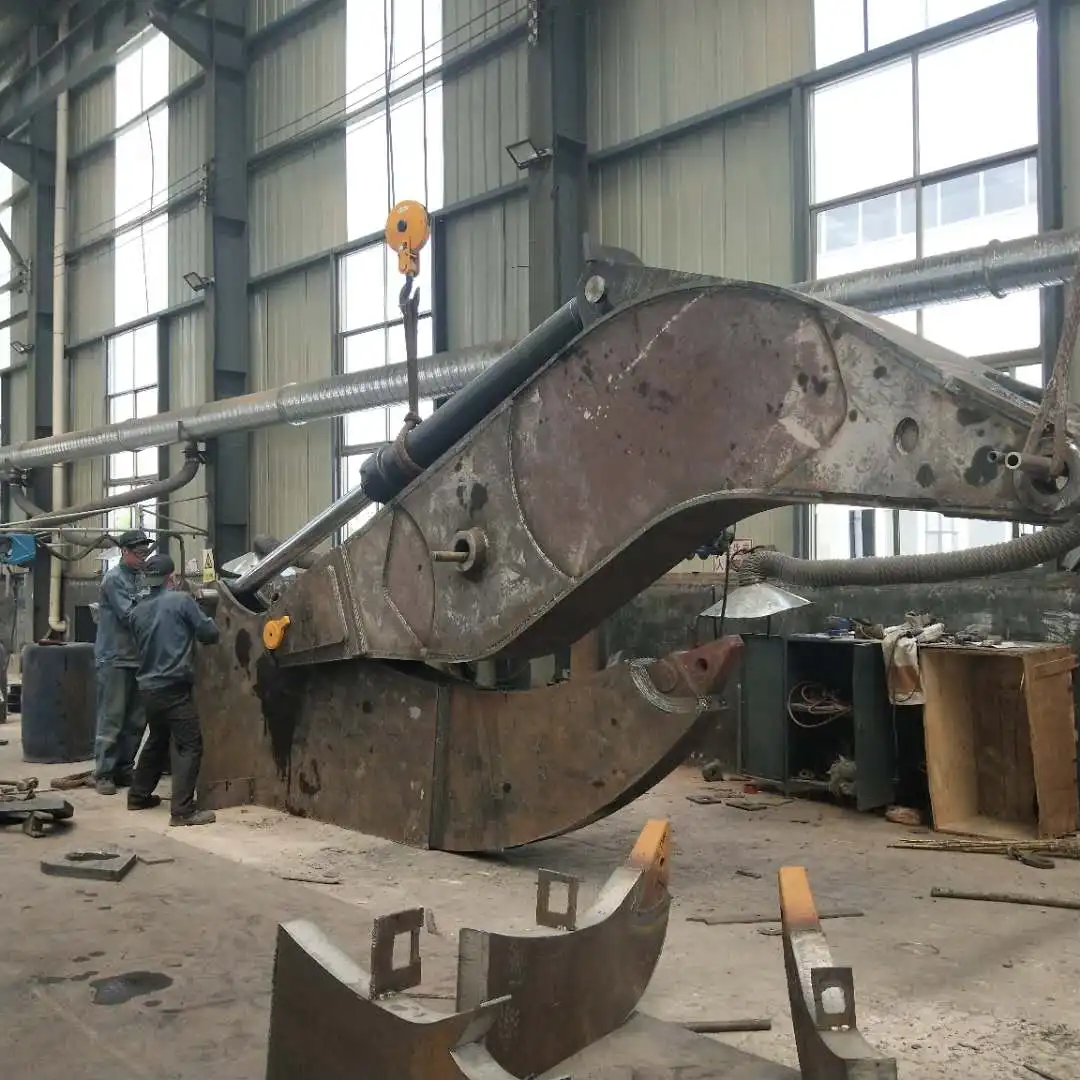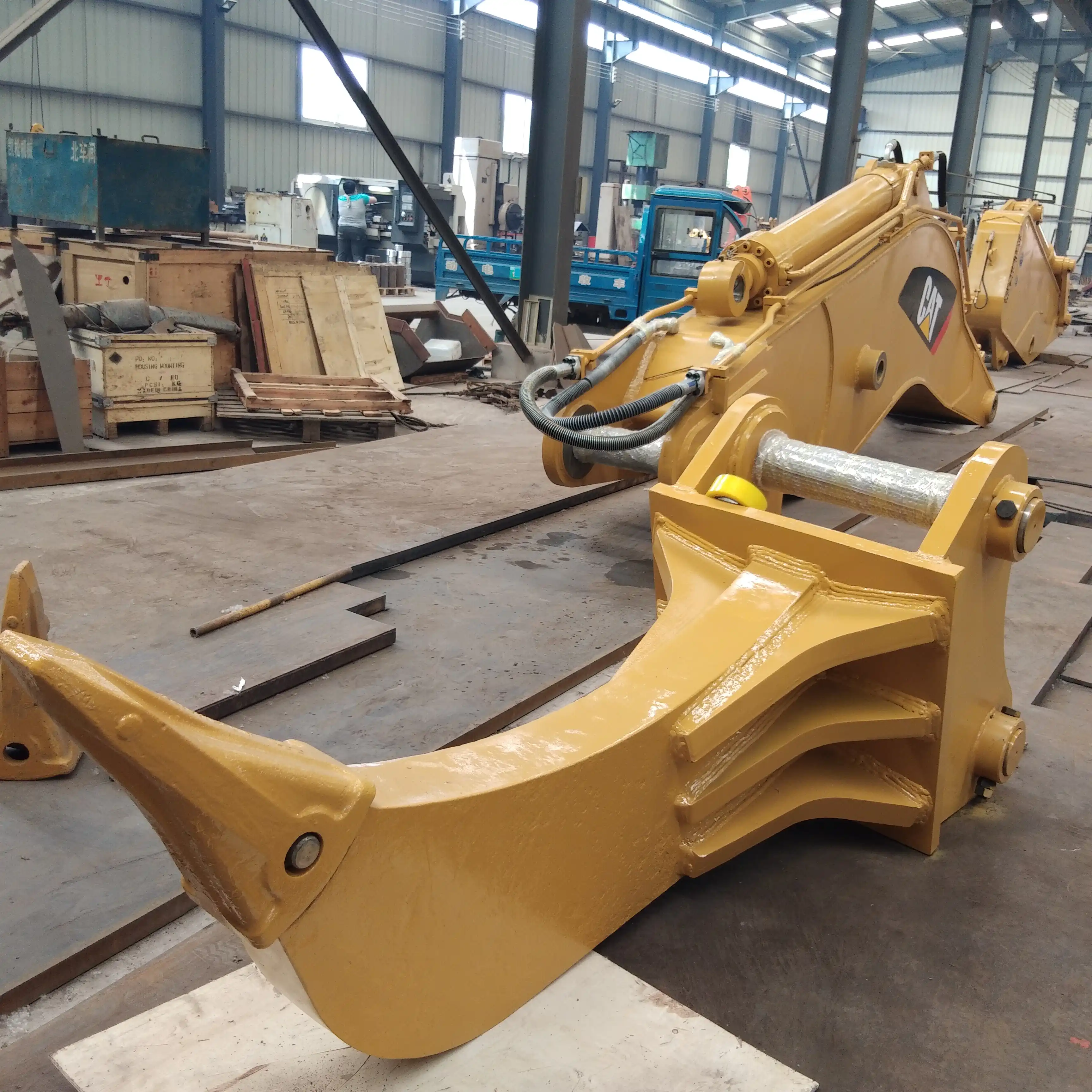Hydraulic Rock Arm For A Quarry Excavator
Quarry operations present unique challenges that demand specialized equipment solutions capable of withstanding punishing conditions while delivering consistent performance. At the heart of efficient quarry production stands the excavator rock arm, a purpose-built hydraulic attachment engineered specifically for the relentless demands of stone extraction and processing. Unlike standard excavator attachments that quickly succumb to the abrasive environment of quarry operations, these specialized implements feature reinforced construction, optimized hydraulic systems, and purpose-designed geometries that enable continuous production in environments where conventional equipment rapidly fails.
The economics of modern quarrying hinges on maximizing material extraction while minimizing operational costs – a delicate balance that quality hydraulic rock arms help achieve. By providing precise control over breaking force and location, these attachments enable quarry operators to extract dimensional stone with minimal waste, preserve material integrity where valuable, and process overburden efficiently. The versatility of a properly specified rock arm transforms a standard excavator into a multi-functional production tool capable of addressing varied material conditions throughout the quarry face. For operations focused on improving productivity while controlling equipment costs, these specialized attachments represent not merely an excavator accessory but a fundamental production asset that directly impacts profitability through enhanced material processing capabilities and reduced downtime.
Design & Construction

Materials Engineering
The foundation of any effective quarry-grade excavator rock arm begins with advanced materials engineering tailored specifically to withstand the punishing conditions of stone extraction operations. Premium attachments incorporate specialized high-strength alloy steels with elongation properties carefully balanced against hardness requirements – a critical engineering consideration that allows components to absorb impact loading without developing fatigue cracks that quickly propagate in lesser materials.
Strategic reinforcement appears throughout the structure, with additional material thickness at high-stress zones identified through sophisticated finite element analysis during the design phase. This targeted approach enhances durability without unnecessary weight that would compromise excavator performance and stability. Wear-resistant overlay materials strategically applied at contact points provide exceptional abrasion resistance, significantly extending service intervals in highly abrasive stone environments where standard attachments quickly develop catastrophic wear patterns.
Connection points between the arm and excavator boom receive particular attention, with oversized bushings manufactured from specialized bearing materials that maintain dimensional stability even under extreme cyclical loading. Hardened pins with precision tolerances minimize play that would otherwise quickly develop into component-damaging movement. These seemingly minor design details dramatically influence attachment longevity, with premium components often delivering three to five times the service life of standard alternatives when operating in demanding quarry applications.
Structural Configuration
The architectural design of quarry-specific rock arms reflects a deep understanding of stone extraction requirements and material behavior under stress. The attachment's overall geometry incorporates precise leverage ratios calculated to maximize effective breaking force while distributing stress throughout the structure rather than concentrating it at vulnerable points. This holistic design approach allows the attachment to generate substantially higher effective working force than its raw hydraulic specifications might suggest.
Articulation points feature carefully calculated movement ranges that provide operational versatility while preventing overextension that could damage hydraulic components or create unsafe working conditions. The arm's range of motion allows operators to address material at various heights and orientations without repositioning the excavator – a significant productivity advantage in quarry environments where frequent machine movement increases wear on undercarriages while reducing effective production time.
The interface between the rock arm and the excavator boom incorporates universal mounting systems compatible with multiple carrier machines, allowing quarry operations to maintain attachment commonality across mixed equipment fleets. This interchangeability provides valuable operational flexibility while simplifying parts inventory requirements, significant advantages for operations focused on maximizing equipment utilization while controlling maintenance costs.
Protective Elements
Quarry environments subject equipment to extraordinary abuse from dust infiltration, impact loading, and continuous operation in all weather conditions. Comprehensive protection systems represent essential design elements for any excavator rock arm expected to deliver consistent performance in these demanding applications. Hydraulic components receive particular attention, with cylinders, valves, and lines shielded by robust guards specifically designed to deflect falling material while maintaining accessibility for maintenance.
Sealing systems throughout the attachment incorporate multiple redundant barriers against dust infiltration – the primary cause of accelerated wear in quarry equipment. Specialized dust excluders, positive pressure systems, and advanced seal materials work together to maintain internal component cleanliness even when operating in environments where airborne particulate levels would quickly destroy conventional equipment. These protection systems dramatically extend service intervals while reducing catastrophic failures that interrupt production.
Surface protection extends beyond mere aesthetics, with industrial coating systems specifically formulated to withstand both ultraviolet degradation and chemical exposure from groundwater or process materials. Multi-layer finishing processes typically incorporate zinc-rich base layers that provide sacrificial protection against corrosion even if the outer coating becomes damaged during operation. This comprehensive approach to surface protection maintains both functionality and residual value, important considerations for equipment representing significant capital investment.
Technical Specifications

Hydraulic System Capabilities
The hydraulic system represents the functional heart of any rock arm, with quarry applications demanding exceptional performance characteristics that exceed standard construction-grade specifications. Premium quarry-grade attachments feature cylinders with substantial inner diameters – 200mm for 40-45T excavators, 220mm for 60-65T machines, and an impressive 3670mm for heavy-duty 80-100T equipment. These oversized components generate the tremendous forces necessary to fracture even the most resilient stone formations effectively.
Operating pressures typically range from 320 to 380 bar, depending on specific application requirements and carrier machine capabilities. These elevated pressure ratings enable the attachment to deliver consistent breaking force even when encountering material variability throughout the quarry face. Pressure relief systems provide essential protection against hydraulic shock when breaking through material unexpectedly or encountering exceptionally hard inclusions within the formation.
Control systems incorporate proportional valve technology that allows operators to modulate force application precisely – a critical capability when extracting dimensional stone where excessive force would damage valuable material. This fine control represents a significant advantage over fixed-force breaking systems, allowing the rock arm to function effectively across diverse material conditions from overburden removal to precision extraction of finished blocks.
Dimensional Characteristics
Physical dimensions significantly influence rock arm functionality in quarry applications, with each size category optimized for specific operational requirements. Maximum operating ranges vary by excavator class: 6300mm for 40-45T machines, 7400mm for 60-65T equipment, and 7600mm for heavy-duty 80-100T excavators. These extended reaches allow operators to address substantial quarry faces without frequent repositioning, maintaining productive breaking angles while keeping the carrier machine at safe distances from potentially unstable material.
Working envelopes incorporate both vertical and horizontal reach considerations, with articulation ranges calculated to provide coverage throughout typical quarry face geometries. This comprehensive working range allows a single properly positioned excavator to process substantial material volumes without repositioning – a significant productivity advantage in operations where machine movement represents non-productive time.
Transport dimensions receive careful consideration in the design process, with folding configurations that allow road transport without special permits in most jurisdictions. This mobility consideration proves particularly valuable for quarry operations utilizing multiple extraction sites or contractors serving multiple quarry clients with the same equipment. Quick-connect systems expedite attachment changes, allowing operations to reconfigure equipment quickly as production requirements evolve.
Performance Metrics
Practical performance in quarry applications depends on multiple interrelated factors beyond raw breaking force. Production rates vary with material characteristics, but properly specified excavator rock arms typically process between 25-60 cubic meters per hour depending on fracture patterns, material density, and operator skill. This throughput represents a significant advantage over alternative breaking methods, particularly when considering the attachment's ability to maintain continuous production without the delays associated with drilling and blasting operations.
Energy efficiency metrics provide valuable insight into operating economics, with hydraulic monitoring systems reporting actual energy transfer rates during breaking operations. Advanced attachments deliver impressive force-to-energy ratios by minimizing hydraulic losses and optimizing force application angles – efficiencies that translate directly to reduced fuel consumption and lower operating costs per ton of material processed.
Cycle time analysis reveals additional performance advantages, with quarry-grade rock arms typically achieving 12-18 complete breaking cycles per minute in moderate material and 8-12 cycles in extremely hard formations. This cycle frequency optimization balances impact force against recovery time, allowing the hydraulic system to maintain consistent performance without overheating or pressure drops that would compromise breaking effectiveness.
Selection Criteria

Matching to Material Characteristics
Effective excavator rock arm selection begins with comprehensive analysis of quarry material properties. Compressive strength measurements provide fundamental data points, with typical dimension stone quarries encountering materials ranging from 100 MPa for many limestones to over 250 MPa for dense granites and basalts. These strength variations demand corresponding differences in breaking force capabilities, with higher-strength materials requiring larger cylinder diameters and operating pressures.
Fracture characteristics influence both tool selection and breaking technique. Highly stratified stones with pronounced bedding planes often respond well to lateral breaking approaches that exploit natural weakness planes. Homogeneous materials typically require direct application of maximum force to initiate fracture propagation. Understanding these material-specific behaviors allows operators to maximize productivity while minimizing energy consumption – important considerations in production environments where fuel represents a significant operating expense.
Abrasiveness assessments guide wear component selection, with highly siliceous materials requiring specialized wear packages that substantially outperform standard components. This material-driven customization significantly impacts operating economics through extended service intervals and reduced component replacement frequency. Operations processing highly abrasive materials often justify premium attachment specifications through dramatically reduced maintenance requirements and improved uptime statistics.
Operational Integration Requirements
Integration with existing equipment and operational workflows represents a critical selection factor often overlooked during the specification process. Hydraulic compatibility assessments should include both flow capacity and pressure limitations of the carrier excavator, ensuring the attachment operates within optimal parameters rather than constraining performance through hydraulic limitations. Auxiliary hydraulic circuits may require upgrading on older equipment to fully utilize modern excavator rock arm capabilities.
Physical mounting considerations extend beyond basic dimensional compatibility to include boom strength verification and counterweight adequacy. Undersized carrier machines may require additional counterweighting to maintain stability when operating rock arms at extended reaches – a safety consideration that directly impacts operational capabilities. Comprehensive stability analysis during the selection process prevents dangerous operating conditions while ensuring the carrier machine maintains full functionality.
Control system integration influences both productivity and operator acceptance, with modern attachments offering electronic interfaces compatible with excavator control systems. These integrated controls allow operators to maintain familiar operating patterns while accessing attachment-specific functions through existing control interfaces. This seamless integration reduces training requirements while improving operational precision, factors that significantly impact production rates during initial implementation periods.
Economic Considerations
Return on investment calculations should incorporate comprehensive operational cost analysis rather than focusing exclusively on initial acquisition expense. Premium quarry-grade rock arms typically command 15-25% higher purchase prices than construction-grade alternatives but deliver substantially lower per-ton processing costs through improved productivity and reduced maintenance requirements. This lifetime cost advantage often represents a 30-40% improvement over the attachment's operational lifespan.
Maintenance economics favor well-designed excavator rock arms through replaceable wear components that extend the attachment's useful life indefinitely. Rather than replacing entire assemblies, operators can focus maintenance budgets on specific wear points, optimizing operational expenses while maintaining peak performance. Comprehensive maintenance programs typically achieve 85-90% planned maintenance ratios compared to 50-60% for standard attachments – a significant advantage in production environments where unplanned downtime directly impacts revenue.
Productivity improvements contribute substantially to economic justification, with properly specified attachments increasing through-put by 20-35% compared to general-purpose alternatives. This production advantage compounds throughout the operational chain, improving crusher utilization, reducing secondary processing requirements, and enhancing overall quarry output without corresponding increases in fixed overhead costs. These comprehensive economic benefits often justify premium attachment specifications even for operations working under tight capital constraints.
FAQ
①What excavator size works best for typical dimension stone quarrying?
For most dimensional stone applications, excavators in the 40-45T range with 200mm cylinder diameter rock arms provide optimal versatility. This configuration delivers sufficient breaking force for most limestone and marble extraction while maintaining the precision necessary for quality production. Harder stone types like granite may require 60-65T machines with 220mm cylinders to maintain productive breaking rates.
②How do maintenance requirements compare to standard excavator attachments?
Quarry operations typically accelerate wear rates significantly compared to standard construction applications. Daily inspection routines should focus on hydraulic connection points, pivot bushings, and tool wear patterns. Professional quarry operations typically implement 250-hour major inspection intervals rather than the 500-hour standards common in construction applications.
③Can rock arms extract stone without damaging valuable material?
Quality hydraulic rock arms with proportional control systems allow skilled operators to create controlled fractures along natural stone cleavage planes, preserving material integrity while facilitating extraction. This precision capability represents a significant advantage over explosives or pneumatic breakers in premium stone operations where material value directly correlates with block integrity.
④What productivity improvements can quarries expect?
When properly matched to material characteristics, excavator rock arms typically improve overall extraction rates by 25-40% compared to traditional methods while simultaneously reducing waste material by 15-20%. Additional economic benefits derive from eliminated drilling costs, reduced labor requirements, and improved processing consistency.
⑤How should quarry operations evaluate attachment quality?
Beyond basic specifications, evaluate metallurgical quality through hardness testing of wear components, examine hydraulic component sourcing from recognized manufacturers, and review seal system design for dust exclusion capabilities. Request wear component availability guarantees and review maintenance documentation comprehensiveness as quality indicators.
About Tiannuo
The hydraulic rock arm represents an essential productivity tool for modern quarry operations confronting challenging material extraction requirements. With specialized construction, optimized hydraulic systems, and quarry-specific design features, these attachments transform standard excavators into highly effective stone processing machines capable of maintaining productivity where conventional equipment would fail.
Tiannuo Machinery's commitment to engineering excellence ensures their quarry-grade rock arm products deliver exceptional performance while maintaining the durability demanded by professional quarry operators. Their comprehensive range accommodates various excavator sizes from 40 to 100 tons, with each model optimized for specific carrier equipment and quarrying applications.
For quarry operations serious about maximizing extraction efficiency while controlling operational costs, the investment in quality hydraulic attachments pays significant dividends through improved productivity, reduced processing waste, and enhanced operational flexibility. To learn more about selecting the ideal rock arm configuration for your specific quarrying application requirements, contact Tiannuo's technical specialists at tn@stnd-machinery.com.
References
- International Journal of Stone Processing Technology: "Advancements in Mechanical Extraction Methods for Dimensional Stone Quarrying" (2023)
- Quarry Management Professional Publication: "Economic Analysis of Hydraulic Breaking vs. Traditional Extraction Methods in Modern Dimension Stone Operations" (2024)
- Society of Quarry Engineers Technical Bulletin: "Optimization Strategies for Hydraulic Equipment in Hard Stone Processing Applications" (2023)
- International Stone Industry Association Report: "Equipment Selection Guidelines for Sustainable Quarry Operations" (2024)
- Journal of Mining and Quarrying Technology: "Material-Specific Breaking Methodologies for Premium Stone Extraction" (2023)
About Author: Arm
Arm is a leading expert in the field of specialized construction and railway maintenance equipment, working at Tiannuo Company.

